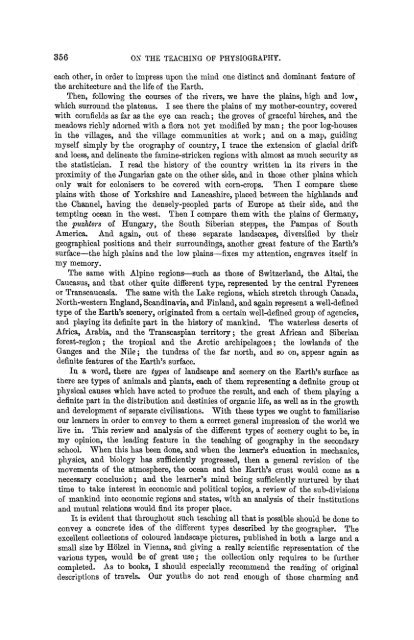On the Teaching of Physiography Author(s): P. Krapotkin Source ...
On the Teaching of Physiography Author(s): P. Krapotkin Source ...
On the Teaching of Physiography Author(s): P. Krapotkin Source ...
Create successful ePaper yourself
Turn your PDF publications into a flip-book with our unique Google optimized e-Paper software.
356ON THE TEACHING OF PHYSIOGRAPHY.each o<strong>the</strong>r, in order to impress upon <strong>the</strong> mind one distinct and dominant feature <strong>of</strong><strong>the</strong> architecture and <strong>the</strong> life <strong>of</strong> <strong>the</strong> Earth.Then, following <strong>the</strong> courses <strong>of</strong> <strong>the</strong> rivers, we have <strong>the</strong> plains, high and low,which surround <strong>the</strong> plateaus. I see <strong>the</strong>re <strong>the</strong> plains <strong>of</strong> my mo<strong>the</strong>r-country, coveredwith cornfields as far as <strong>the</strong> eye can reach; <strong>the</strong> groves <strong>of</strong> graceful birches, and <strong>the</strong>meadows richly adorned with a flora not yet modified by man; <strong>the</strong> poor log-housesin <strong>the</strong> villages, and <strong>the</strong> village communities at work; and on a map, guidingmyself simply by <strong>the</strong> orography <strong>of</strong> country, I trace <strong>the</strong> extension <strong>of</strong> glacial driftand loess, and delineate <strong>the</strong> famine-stricken regions with almost as much security as<strong>the</strong> statistician. I read <strong>the</strong> history <strong>of</strong> <strong>the</strong> country written in its rivers in <strong>the</strong>proximity <strong>of</strong> <strong>the</strong> Jungarian gate on <strong>the</strong> o<strong>the</strong>r side, and in those o<strong>the</strong>r plains whichonly wait for colonisers to be covered with corn-crops. Then I compare <strong>the</strong>seplains with those <strong>of</strong> Yorkshire and Lancashire, placed between <strong>the</strong> highlands and<strong>the</strong> Channel, having <strong>the</strong> densely-peopled parts <strong>of</strong> Europe at <strong>the</strong>ir side, and <strong>the</strong>tempting ocean in <strong>the</strong> west. Then I compare <strong>the</strong>m with <strong>the</strong> plains <strong>of</strong> Germany,<strong>the</strong> puzhters <strong>of</strong> Hungary, <strong>the</strong> South Siberian steppes, <strong>the</strong> Pampas <strong>of</strong> SouthAmerica. And again, out <strong>of</strong> <strong>the</strong>se separate landscapes, diversified by <strong>the</strong>irgeographical positions and <strong>the</strong>ir surroundings, ano<strong>the</strong>r great feature <strong>of</strong> <strong>the</strong> Earth'ssurface-<strong>the</strong> high plains and <strong>the</strong> low plains-fixes my attention, engraves itself inmy memory.The same with Alpine regions-such as those <strong>of</strong> Switzerland, <strong>the</strong> Altai, <strong>the</strong>Caucasus, and that o<strong>the</strong>r quite different type, represented by <strong>the</strong> central Pyreneesor Transcaucasia. The same with <strong>the</strong> Lake regions, which stretch through Canada,North-western England, Scandinavia, and Finland, and again represent a well-definedtype <strong>of</strong> <strong>the</strong> Earth's scenery, originated from a certain well-defined group <strong>of</strong> agencies,and playing its definite part in <strong>the</strong> history <strong>of</strong> mankind. The waterless deserts <strong>of</strong>Africa, Arabia, and <strong>the</strong> Transcaspian territory; <strong>the</strong> great African and Siberianforest-region; <strong>the</strong> tropical and <strong>the</strong> Arctic archipelagoes; <strong>the</strong> lowlands <strong>of</strong> <strong>the</strong>Ganges and <strong>the</strong> Nile; <strong>the</strong> tundras <strong>of</strong> <strong>the</strong> far north, and so on, appear again asdefinite features <strong>of</strong> <strong>the</strong> Earth's surface.In a word, <strong>the</strong>re are types <strong>of</strong> landscape and scenery on <strong>the</strong> Earth's surface as<strong>the</strong>re are types <strong>of</strong> animals and plants, each <strong>of</strong> <strong>the</strong>m representing a definite group otphysical causes which have acted to produce <strong>the</strong> result, and each <strong>of</strong> <strong>the</strong>m playing adefinite part in <strong>the</strong> distribution and destinies <strong>of</strong> organic life, as well as in <strong>the</strong> growthand development <strong>of</strong> separate civilisations. With <strong>the</strong>se types we ought to familiariseour learners in order to convey to <strong>the</strong>m a correct general impression <strong>of</strong> <strong>the</strong> world welive in. This review and analysis <strong>of</strong> <strong>the</strong> different types <strong>of</strong> scenery ought to be, inmy opinion, <strong>the</strong> leading feature in <strong>the</strong> teaching <strong>of</strong> geography in <strong>the</strong> secondaryschool. When this has been done, and when <strong>the</strong> learner's education in mechanics,physics, and biology has sufficiently progressed, <strong>the</strong>n a general revision <strong>of</strong> <strong>the</strong>movements <strong>of</strong> <strong>the</strong> atmosphere, <strong>the</strong> ocean and <strong>the</strong> Earth's crust would come as anecessary conclusion; and <strong>the</strong> learner's mind being sufficiently nurtured by thattime to take interest in economic and political topics, a review <strong>of</strong> <strong>the</strong> sub-divisions<strong>of</strong> mankind into economic regions and states, with an analysis <strong>of</strong> <strong>the</strong>ir institutionsand mutual relations would find its proper place.It is evident that throughout such teaching all that is possible should be done toconvey a concrete idea <strong>of</strong> <strong>the</strong> different types described by <strong>the</strong> geographer. Theexcellent collections <strong>of</strong> coloured landscape pictures, published in both a large and asmall size by Holzel in Vienna, and giving a really scientific representation <strong>of</strong> <strong>the</strong>various types, would be <strong>of</strong> great use; <strong>the</strong> collection only requires to be fur<strong>the</strong>rcompleted. As to books, I should especially recommend <strong>the</strong> reading <strong>of</strong> originaldescriptions <strong>of</strong> travels. Our youths do not read enough <strong>of</strong> those charming and














![The Philosophy of Progress [pdf]](https://img.yumpu.com/14077359/1/190x245/the-philosophy-of-progress-pdf.jpg?quality=85)

